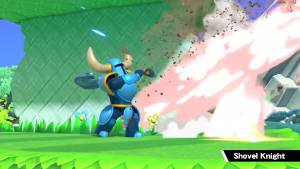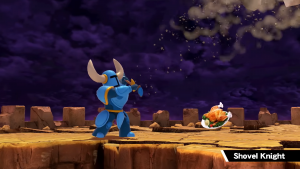In this week’s Super Smash Bros. Ultimate Direct, Nintendo announced that the titular hero of Shovel Knight would appear as an assist trophy. While there has been one smaller case of indie representation in Super Smash Bros., Shovel Knight’s larger prominence marks an important precedent for the future.
However, it is important to make a distinction between the multiple “tiers” of representation in Super Smash Bros. The most coveted tier, a playable fighter has his or her own set of moves. Even “echo fighters” get a space on the roster, but they share most of their moves with another fighter.
On the other hand, AI controls the assist trophies’ movement, assisting one player by creating a hazard for others. The more common trophies are simply collectables of various characters with a 3D model and a short text description.
In terms of a film, playable characters are the leading actors, echo fighters are the supporting roles, assist trophies are cameos, and trophies are the ensemble. However, any appearance in Super Smash Bros. is usually a huge honor for most developers, regardless of how large it is.

Steel Thy Shovel!
Shovel Knight jumps across the stage, using his signature “Shovel Drop” to bounce on the player’s adversaries, dealing damage. He can also use his other move, “Dig Slash,” to either attack or uncover a surprisingly photorealistic piece of chicken to recover the player’s health, a reference to the original Shovel Knight. Like many assist trophies in Ultimate, he can be defeated, which deals damage to the player being “assisted.”
Only one other indie game has ever been represented in Super Smash Bros., in the form of Commander Video from the Bit.Trip series. However, Commander Video was simply a trophy, whereas Shovel Knight will be an assist trophy. It’s an important distinction, because while simple trophies very well might reach above a thousand in Ultimate, there likely won’t be many more than 50 assist trophies.

While still amazing, if it was going to be anyone, it was going to be Shovel Knight. The game has sold over two million copies, over a million of which are on Nintendo platforms, largely thanks to multiple timed exclusivity deals with the company. That’s more sales than many AAA games get, many of which made it into Smash Bros. as original fighters. Nintendo even published the game themselves in Japan, meaning that it was a Nintendo exclusive for even longer overseas!
More important, however, is how this sets further precedence for indie representation in either future Super Smash Bros. games or in Ultimate as new announcements or future DLC. Considering how we’ve already seen indie representation “rise the ranks,” it’s not too outlandish to expect this trend to continue.
Perhaps one day we will see a character from an indie game, Shovel Knight or otherwise, take the coveted position of a full-fledged fighter. Super Smash Bros. is one of the largest video game crossovers of all time, and is always a chaotic celebration of the entire medium. Indie games deserve to be a larger part of that celebration.



